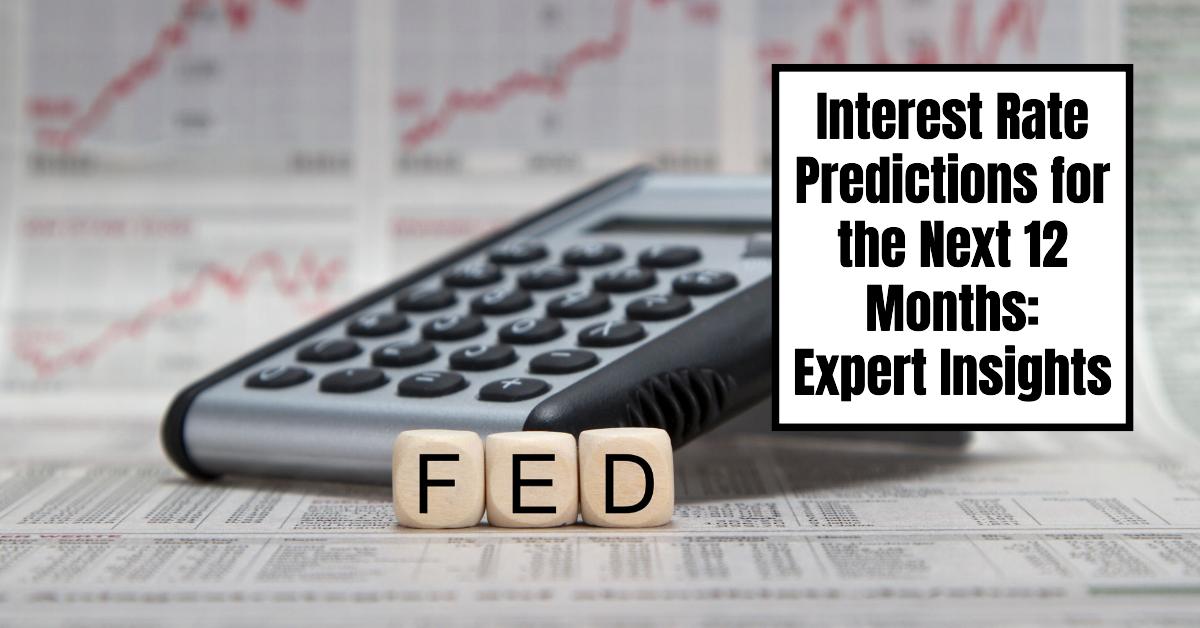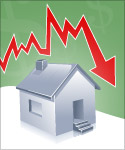The Federal Reserve is expected to continue reducing interest rates over the next year, with forecasts generally pointing to the federal funds rate landing somewhere between 3.4% and 3.6% by the end of 2026. It’s a bit of a balancing act the Fed is performing right now, trying to coax the economy along without reigniting inflation or causing it to overheat.
Federal Reserve Interest Rate Predictions for Next 12 Months
What the Fed does with rates ripples through everything from your mortgage payment to how much you earn on your savings account. So, when we talk about interest rate predictions for the next 12 months, we're essentially talking about the economic weather forecast for the near future.
As of October 2025, the Federal Reserve has set its target range for the federal funds rate at 4.00%–4.25%. This follows a 25 basis point cut in September, a move that signaled the Fed was shifting gears. The actual effective rate, what banks are really paying each other to borrow overnight, is hovering around 4.09%.
The general sentiment, and what the market is largely betting on, is that we'll see more cuts coming down the pipeline. In fact, many believe there's a high chance of another cut at the upcoming October 28–29 meeting, and possibly another one in December. This could nudge the rate down to around 3.50%–3.75% by the close of 2025.
Now, the Federal Reserve itself offers some insight through its projections, known as the “dot plot.” The latest one from September 2025 suggests a median federal funds rate of 3.6% by the end of 2025 and then easing further to 3.4% by the end of 2026. This paints a picture of a gradual easing path, with the Fed seeing the risks to inflation and employment as fairly balanced. But, as we’ll dig into, there are always curveballs that could throw these predictions off course.
Understanding the Fed's Role and Why Rates Matter
Before we dive deeper into where rates might be headed, it’s super important to understand what the Federal Reserve (or the Fed, as we affectionately call it) actually does. Established way back in 1913, it’s the central bank of the United States. Its main gigs? To keep prices stable (that means controlling inflation), help foster maximum employment, and aim for moderate long-term interest rates.
The federal funds rate is the Fed’s main tool. Think of it as the price banks pay to borrow money from each other overnight. When the Fed changes this rate, it’s like turning a dial that affects borrowing costs all across the economy. Want to cool down an overheating economy and fight inflation? The Fed raises rates, making borrowing more expensive, which tends to slow down spending and investment. Need to give the economy a boost because things are feeling sluggish and people are losing jobs? The Fed cuts rates, making borrowing cheaper and encouraging more spending and investment.
We’ve seen these rates swing wildly throughout history. Back in the early 1980s, they were sky-high, nearing 20%, to combat rampant inflation. Then, during the 2008 financial crisis and the COVID-19 pandemic, they were slashed to near zero to try and keep the economy from collapsing. We’ve just come out of a period, 2022–2023, where the Fed aggressively hiked rates to fight the inflation that popped up after the pandemic. Now, in 2025, we’re seeing the beginnings of rate cuts. The last five years alone have been a rollercoaster: near zero in 2020–2021, rapid hikes in 2022–2023, a pause in 2024, and now the gentle descent in 2025.
The decisions about these rates are made by a group called the Federal Open Market Committee (FOMC). They meet eight times a year to discuss and decide on monetary policy. So, when you hear about the Fed's next move, it’s usually following one of these scheduled meetings. The meetings in October 28–29, 2025, and December 9–10, 2025, are key dates on the calendar for the next 12 months.
The Current Economic Picture: Why the Shift?
Entering 2025, the Fed had been holding rates steady at a higher level (around 4.25%–4.50%) for quite a while. The main focus was keeping inflation in check, which had been stubbornly high. However, as 2025 progressed, some economic indicators started to signal a potential shift. The labor market, while still strong by many measures, began showing signs of softening. This, combined with inflation that was gradually moderating, gave the FOMC enough confidence to make that 25 basis point cut in September.
It wasn’t a panicked move; the Fed often describes these as “insurance cuts.” It's like putting on a raincoat even if it's not pouring yet, just in case the weather turns sour. Even though economic growth forecasts had improved, they wanted to provide a cushion against potential downturns, especially in the job market.
So, what are these economic indicators looking like?
- Inflation: The Fed’s preferred gauge, the Personal Consumption Expenditures (PCE) price index, was running around 2.6% year-over-year in mid-2025. That’s a significant drop from the peaks above 7% seen a couple of years prior, but still above the Fed’s target of 2%. The core PCE (which excludes volatile food and energy prices) was a bit stickier, projected around 2.6% for 2026.
- Unemployment: The unemployment rate was sitting at 4.5%. This is considered a healthy level, but the Fed is watching closely for any acceleration that might suggest the economy is weakening too much.
- Economic Growth: Gross Domestic Product (GDP) growth for 2025 was revised upwards in some projections to around 1.6%, showing some resilience. However, there's always a concern that higher interest rates, even if being cut, have a lagged effect and could slow things down more than anticipated.
Globally, things are never static. Geopolitical tensions, supply chain hiccups, and changes in international trade can all throw a wrench into economic plans and might influence the Fed’s decisions.
Peering into the Crystal Ball: Rate Predictions for the Next 12 Months
Alright, let's get to the heart of the matter: What's likely to happen with interest rates over the next 12 months, say, through October 2026? The general consensus is that the easing trend will continue, but how fast and how far is where the debate lies.
The Fed’s own September 2025 dot plot is a really important guide. It suggests the median federal funds rate will be around 3.6% by the end of 2025. That implies about two more 25 basis point cuts from where we are now (effectively 50 basis points in total from October onward). Then, it clocks in at 3.4% by the end of 2026, meaning another quarter-point cut in 2026. This is a more dovish outlook than their June projections, showing they feel more confident that inflation is moving in the right direction.
But the markets, and especially traders who bet on future rates, often have a slightly more aggressive view. Based on market pricing (like Fed funds futures), there's a very high probability, close to 100%, of a 25 basis point cut in October 2025 and a high probability (around 88%) for another one in December 2025. Some market watchers are even calling for the rate to hit around 3.0% by the end of 2026, which would mean more cuts than the Fed's own median forecast suggests.
Economists tend to agree with the general direction but vary on the specifics. Here’s a snapshot of what some of the big players are saying:
| Source | End-2025 Rate | End-2026 Rate | Total Cuts (2025–2026 est.) | Key Takeaway |
|---|---|---|---|---|
| Fed Dot Plot (Median) | 3.6% | 3.4% | 75 basis points | Gradual easing, balanced risks. |
| J.P. Morgan | roughly 3.50%–3.75% | roughly 3.25%–3.50% | 75 basis points | Focus on labor risks; pause if economy holds. |
| Morningstar | roughly 3.75% | roughly 3.00% | 125 basis points | Steadier path towards neutral rates. |
| Trading Economics | roughly 3.50% | roughly 3.25% | 75 basis points | Largely aligns with Fed expectations. |
| Charles Schwab | roughly 3.50%–3.75% | roughly 3.25%–3.50% | 75 basis points | Anticipates one cut in 2026; above neutral. |
| Deloitte (for late 2026) | N/A | Modest hikes possible | Variable | If growth accelerates, rates could tick up late 2026. |
It's interesting to see how different firms interpret the same data. Some, like Morningstar, see a bit more aggressive cutting than the Fed's median. Others, like Deloitte, even throw in the possibility of hikes later in 2026 if the economy really starts sprinting. Discussions you see online, on platforms like X (formerly Twitter), also echo this sentiment, with many expecting around 50 basis points of cuts in 2025 and a couple more in 2026.
What’s Driving These Predictions? The Key Factors
Why are these predictions what they are? It boils down to a few crucial economic pieces:
- Inflation Trends: This is the big one. The Fed’s magic number is 2% inflation. Right now, we’re above that, but the trend is down. If inflation proves stickier than expected, particularly in areas like housing costs (shelter inflation) or services, the Fed might slow down its rate cuts. On the flip side, a sharp drop in energy prices could give them more room to cut faster.
- The Strength of the Labor Market: We expect unemployment to stay relatively low, around 4.5% for 2025 and maybe dipping to 4.4% in 2026. If job growth weakens significantly, the Fed might feel compelled to cut rates more aggressively to prevent a sharp rise in unemployment. Conversely, if the job market stays incredibly robust, they might cut fewer times.
- Economic Growth (GDP): As mentioned, GDP growth forecasts are looking okay for 2025 and 2026, suggesting the economy can handle the current rate environment and even a bit of further easing without overheating. But if consumers start pulling back on spending, or businesses cut back on investment, that could signal a slowdown that warrants more rate cuts.
- Global Economic and Geopolitical Factors: Big events matter. A trade war heating up, a major conflict erupting, or significant economic slowdowns in other major countries could all influence the U.S. economy and, by extension, the Fed's decisions. A global slowdown might encourage the Fed to cut rates, while a sudden spike in global commodity prices could add to inflation concerns and make them more cautious.
- Politics: While the Fed always stresses its independence, it’s impossible to ignore that elections and government policies can intersect with monetary policy. Fiscal policies, like government spending or tax laws, can impact deficits and economic demand, which the Fed has to consider.
Who Gets Affected and How? The Ripple Effects
So, if interest rates do come down, who wins and who needs to pay attention?
- Consumers and Borrowers: This is often the most direct impact. Lower interest rates mean cheaper borrowing.
- Mortgages: Rates on 30-year fixed mortgages, currently around 6.5%, could potentially ease a bit. Some experts think an October cut might help push them slightly lower, though factors like housing demand and inventory are also huge players. While lower rates are great for new buyers and those refinancing, remember that stubbornly high home prices are still a major hurdle for affordability. By late 2026, if cuts proceed as expected, we might see mortgage rates inching down towards the 6.4% range.
- Auto Loans and Credit Cards: Rates on these will likely follow the federal funds rate down, making car purchases and carrying balances a bit less expensive.
- Savers and Investors:
- Savers: If you’ve been enjoying higher yields on your savings accounts, money market funds, or Certificates of Deposit (CDs), those rates will likely decline as the Fed cuts. This pushes people to look for higher-yielding investments, potentially in riskier assets.
- Stock Market: Lower interest rates generally make stocks more attractive. Companies can borrow money more cheaply to invest and expand, and investors might shift money out of lower-yielding bonds and into stocks seeking better returns. This effect can sometimes lead to what’s called a “slow melt-up” in stock prices, where they gradually climb as the cost of capital decreases. However, it’s crucial to remember that stock markets can be volatile, and there’s always a risk of overvaluation.
- Bond Market: When interest rates fall, existing bonds with higher coupon payments become more valuable, so bond prices tend to rise. Yields on longer-term bonds, like the 10-year Treasury, are often watched closely. They are projected to be around 4.1% by the end of 2025, down from current levels.
- Businesses: Easier access to cheaper credit can encourage businesses to borrow, invest in new equipment, hire more workers, and expand operations. This can help boost overall economic growth. However, if the Fed cuts rates too quickly and stokes inflation, they might have to reverse course, creating uncertainty.
- Housing Market: As mentioned, lower mortgage rates can help stimulate demand for homes. This could provide a boost, especially for first-time homebuyers who are often most sensitive to borrowing costs. But the persistent shortage of homes for sale in many areas will continue to be a major factor.
- Global Impact: When the U.S. Fed cuts rates, it can sometimes lead to a weaker U.S. dollar relative to other currencies. This can make U.S. exports cheaper and imports more expensive. For emerging markets, a weaker dollar can sometimes be beneficial, making their debt easier to repay, but it can also increase imported inflation.
The Unknowns: Risks and Uncertainties
As much as we try to predict the future, economics is not an exact science. There are always risks that could throw these forecasts for a loop.
- Inflation Upside Risk: What if inflation doesn’t continue to cool smoothly? Persistent wage growth, unexpected supply shocks (like another energy crisis), or strong consumer demand could reignite inflationary pressures. In such a scenario, the Fed might have to pause its rate cuts or, in a worst-case scenario, even consider raising rates again in late 2026, as some analysts have floated as a possibility.
- Recession Risk: On the other hand, what if the economy slows down more sharply than expected? The effects of past rate hikes could bite harder, or a global downturn could pull the U.S. economy down. This would likely prompt the Fed to cut rates more aggressively than currently projected.
- External Shocks: Natural disasters, major geopolitical flare-ups, or unexpected financial system stress could create significant economic disruptions that are impossible to forecast.
- Data Dependence: The Fed itself always preaches that it is “data-dependent.” This means they are constantly watching incoming economic reports—inflation numbers, jobs reports, GDP figures, consumer sentiment—and will adjust their plans based on what that data tells them. This inherent flexibility means forecasts can and do change.
Wrapping It Up: My Take
Looking at all these factors, my personal read on interest rate predictions for the next 12 months is that the most probable path does involve further rate cuts. The Fed seems committed to a gradual easing path, aiming to support employment and economic growth while keeping a close eye on inflation.
I anticipate the Fed will likely make a couple more cuts in late 2025, bringing the federal funds rate into the 3.50%–3.75% range by year-end. The pace in 2026 will be more heavily dependent on how inflation and the labor market evolve. If things stay relatively balanced, we might see another one or two cuts, landing rates between 3.25% and 3.50%.
However, I’m also keeping a close watch on the nuances. The strong resilience seen in some parts of the economy could mean the cutting cycle is shallower than some expect. Conversely, any sign of inflation re-accelerating could quickly put the brakes on further rate reductions. For consumers and investors, this means staying informed is key. Keep an eye on the FOMC statements after their meetings and the latest economic data releases. Don't make major financial decisions solely based on these predictions; they are educatedguesses, not guarantees.
The overall picture for the next year suggests a continuing trend of lower borrowing costs, which is generally good news for borrowers and could provide some tailwinds for the stock market. However, savers will need to continue thinking creatively about how to find decent returns. It's a complex dance, and the Fed is trying to master some tricky footwork.
“Build Wealth Through Turnkey Real Estate”
The Federal Reserve’s decisions on interest rates impact everything—from your mortgage payments to your savings yields. As of October 2025, the Fed’s target range stands at 4.00%–4.25% following a recent 25 basis point cut, with the effective rate hovering near 4.09%.
Market analysts now anticipate additional rate cuts over the coming months—potentially lowering the rate to around 3.50%–3.75% by the end of 2025. This shift could open new opportunities for homebuyers and real estate investors looking to secure better financing terms.
🔥 Lower Rates Mean Smarter Investment Opportunities! 🔥
Talk to a Norada investment counselor today (No Obligation):
(800) 611-3060
Want to Know More?
Explore these related articles for even more insights:
- Federal Reserve Cuts Interest Rate by 0.25%: Two More Cuts Expected in 2025
- Fed Projects Two Interest Rate Cuts Later in 2025
- Interest Rate Predictions for the Next 3 Years: 2025, 2026, 2027
- When is Fed's Next Meeting on Interest Rate Decision in 2025?
- Interest Rate Predictions for the Next 10 Years: 2025-2035
- Interest Rate Predictions for 2025 by JP Morgan Strategists
- Interest Rate Predictions for Next 2 Years: Expert Forecast
- Fed Funds Rate Forecast 2025-2026: What to Expect?
- Interest Rate Predictions for 2025 and 2026 by NAR Chief
- Market Reactions: How Investors Should Prepare for Interest Rate Cut
- Impact of Interest Rate Cut on Mortgages, Car Loans, and Your Wallet




